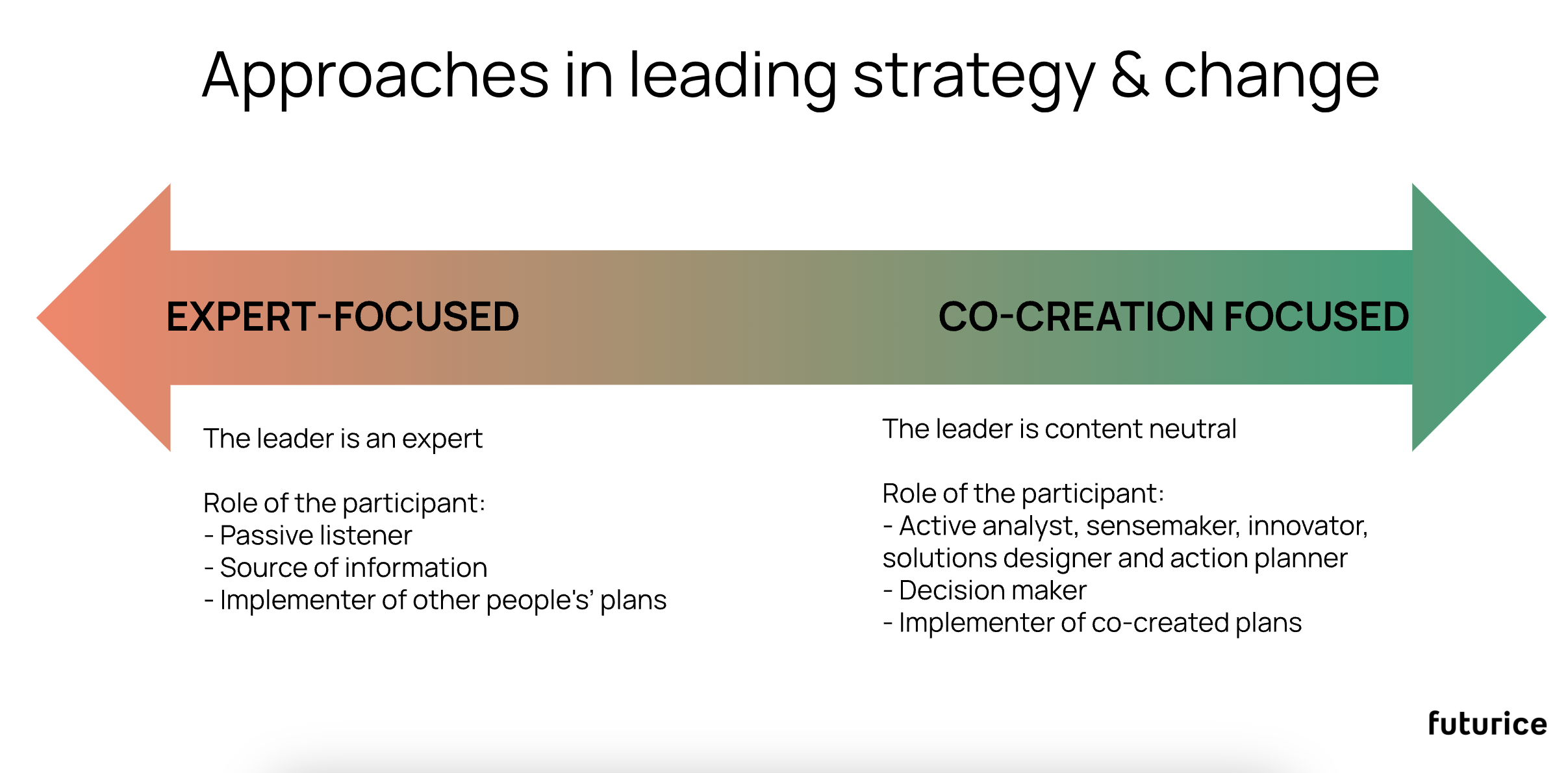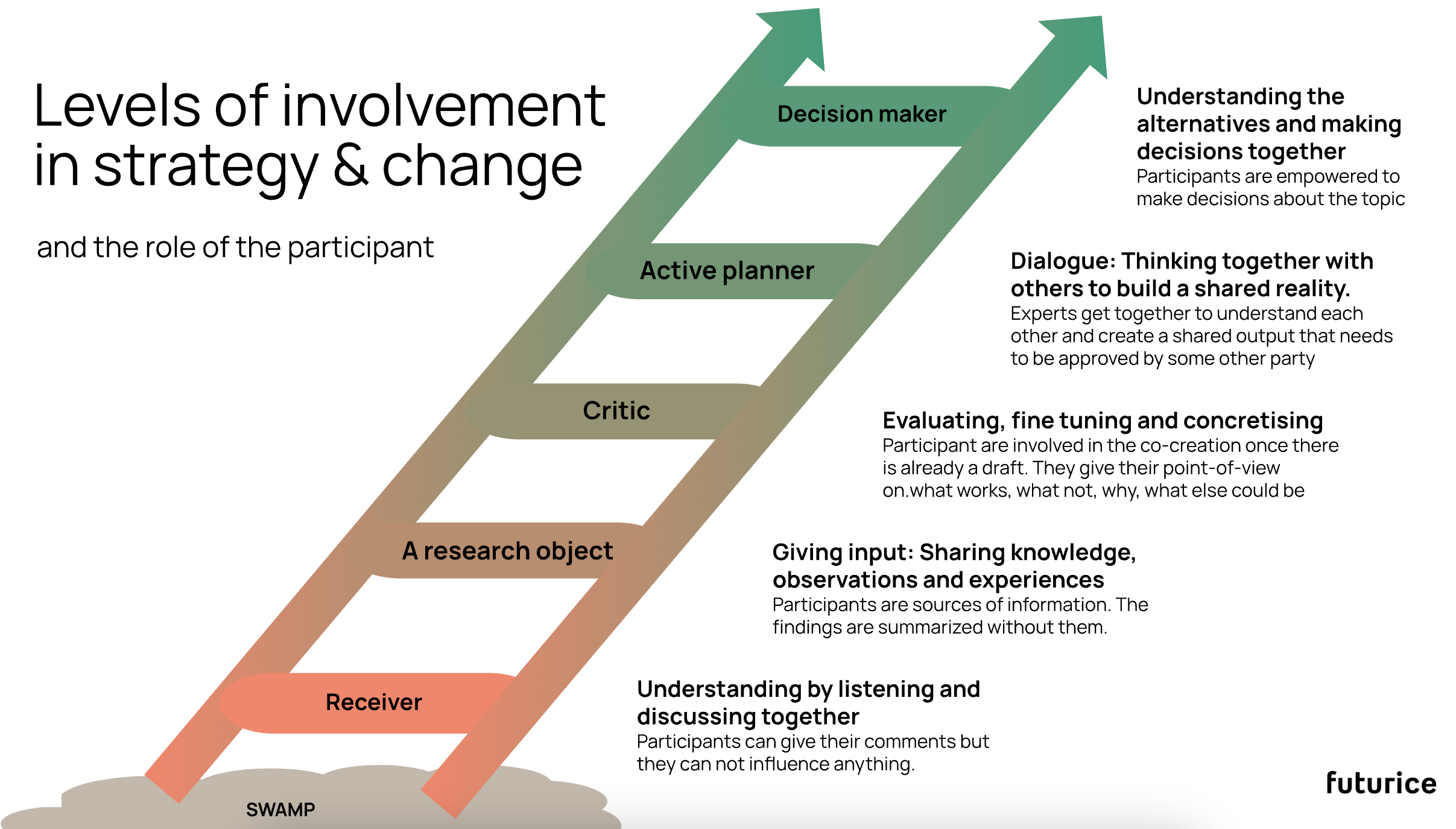Effective use of the ladder of participation in strategy and change
"A larger group should participate in this change initiative, but everyone is so busy that they don't have time to join," struggled one leader. Have you also wondered how to get customers and colleagues involved in change, development, or strategy projects? At what stages? Why?

"Participation – yeah, I’d love to do that, BUT everyone is too busy, so I’ll just send a survey"
A project, that was planned to be iterative and engaging, may wither into one-way communication when the joint time investment seems to escalate too large. One 50-person event that lasts 3 hours means 150 person-hours of work, plus preparation time and documentation. What can be achieved in that time - compared to what three experts can achieve in a week? Ah, let’s skip participation, so much less hassle.
In 2023, I realized there are new technologies that enable involvement of hundreds, even thousands of people in strategic dialogue in a time efficient and scalable way. Groups on different sites can be given a task to talk about a certain topic, discussions recorded and guided, transcribed and synthesized with the help of generative AI. Thrilled about this opportunity I presented it to one experienced strategy consultant, who disgustedly replied: “Why would anyone want to involve hundreds of employees in strategy work?”.
Well, there are different approaches to leading strategy and change. This article compares two of them and helps you figure out how much and how to involve people in your own strategy or change projects – in a time efficient and impactful way.
Without participation, the sense of ownership is absent, making the practical implementation tricky. This might slow down the lead time so much that instead of three months it will turn out to be a year or two to get things implemented.
It is critical to identify which stages of the projects are done by a few experts, and which are larger or smaller group events with genuine participation. In this article, I make the different levels of involvement in projects visible and clarify different amounts and types of participation. A workshop is not the only way to participate, and there are different types of them. And even with the best intentions, you might not get all people on board without first overcoming the obstacles for participation.
How much do you usually engage other people?
Years ago, when my two children were 4 and 6 years old, it was difficult to get them to eat all those healthy things that I wanted them to eat. I had tried to set rules, give rewards, introduce new flavors secretly, make the food look funny – none like that had worked. One day I realized that in our family, it was always me who decided what we eat. I made a hypothesis that involving children in planning what we eat, shopping for ingredients and cooking together could make them more inspired and motivated to eat a wider range of things. I must say that I wasn’t totally content-neutral in those situations, but neither are consultants. We set boundaries and criteria of what a good result looks like. So, my children learned for example to make salad, which had at least four colors and at least one source of protein. They picked (crazy) ingredients from the grocery store, made the salad (with some help) and loved it. Nowadays, they both eat pretty much anything, except mushrooms. We have kept co-creating the week’s menu together with the whole family, and the children occasionally take part in cooking on the level that they are able to. Are the children experts in cooking or nutrition? No, but they can nevertheless participate in a meaningful way.
This story highlights that even as a professional facilitator, I don’t always see the obvious situations where more participation is needed, and I just push my own ideas forward – and face a brick wall. Everyone loves their own ideas the most. Participation can make it possible for a group of people come up with shared ideas that they all see as their own ideas. Then change happens.
To be able to make use of such powerful facilitation methods, the leader of the group needs to first understand which levels of the ladder of participation are suitable for a given situation and topic. Only then comes the decision of who to involve, how much, how, and when.
Two schools of thought

To simplify, the field of organizational development is divided into two schools of thought:
- Expert focused – those who offer mostly deep expertise.
- Co-creation focused – those who mostly facilitate development projects where the participants are the experts. You could also call this process consulting (as Edgar Schein does), but some people confuse that with supply chain consulting and developing other business processes.
Of course, there are many variations in between these two schools of thought, and you can mix them. To clarify the thinking behind the different levels of involvement in organizational development and different leadership styles, I’m using this dualism to get started discussing the topic. This applies whether you are working as a strategy or change leader in an internal role or as an external consultant.
It seems to me that both schools have strong members who believe in the superiority of their own approach. However, it is naive to think that a strategy or a large change or development project can be carried out solely as a series of co-creation workshops. It is equally naive to involve the employee, customer, or stakeholder only in the role of an information source when you expect them to change their mindset and actions.
Expert-centric school of thought
Beliefs
| Most common type of participation
|
Benefits
| Possible challenges
|
Co-creation-centric school of thought
Beliefs
| Levels of participation
|
Benefits
| Possible challenges
|
Ladder of Participation

This ladder illustrates the different levels of involvement. As you can see, there are more than the two extreme schools of thought that I initially described. Expert-centric people and organizations mainly use the bottom three levels, where the participant is a recipient or research subject. The co-creation-centric ones mainly use the highest three levels of participation and call them all co-creation.
The 5 + 1 levels of involvement: The participant is
- a recipient
- a research subject
- a critic
- an active planner
- a decision-maker,
And any of these can also be an implementer.
All these levels of involvement can take place in events called workshops. When you invite people to participate, provide a little more detail about what the event is about, what their role is, how decisions are made, and by whom. Clarity increases professionalism and trust – and better utilization of everyone's contribution.
A successful strategy or change requires identifying different role options, by which the expert, the employee, the client, and maybe even the client's client can participate. Choose the most suitable level and way of participation for each situation, topic, and stakeholder group. Notice that within the same situation, different topics can be on different levels of involvement.
When the project is focused on research work and reports made by a few experts, the bottom levels are most common. This ensures relevant information and an appropriate level of depth. Towards the top of the ladder, participation increases. This enables a deeper mutual understanding of the information, the utilization of the participants' expertise, and commitment to moving forward the concretized results together.
The higher you climb the participation ladder, the stronger the engagement and commitment will be. The dilemma is that you can’t always have everyone stand on top of the ladder, even if you’d like to enable that.
In other words, to put it bluntly, if we only go by the co-creation-focused levels, the team commits to the actions, but not necessarily to the right things. And if we only go by the expert-focused levels, beautiful reports are created but no action. It is crucial you use different ways to involve the right people, at the right time, in the right way.
Should everyone read long reports before workshops?
There are workshops that rely completely on the information that is in people’s own heads: previous experiences, knowledge, and intuition. And there are workshops for which all participants need to digest plenty of preliminary information to be able to fully contribute to the topic at hand. Pre-work takes time too. Answering surveys takes time.
Co-creation focused people who plan workshops often say, “Participants never bother doing pre-work, let’s not bother them with pre-read-materials”. Expert focused people might say “We cannot share all the information related to this, let’s just hear what they have to say”. That’s a strong understatement from both schools of thought.
Not all information can be shared with everyone, yet information is needed to make data-driven decisions. Information asymmetry – some people have it and some people don’t – is one of the biggest obstacles to equal participation. So is information overflow: there is so much information given that honestly, no one can make time to go through that all next to their normal day job.
Some people are used to wolfing down long reports, familiar with the terminology, and tolerating the abashed feeling of not grasping everything on the first bite. Of some other people, it is just not realistic to expect the same. How to contribute if you don’t know all the facts? How to deliver the necessary pre-information for all parties in a way that takes into account neurological diversity, accessibility, and information security? – ouch!
Choose carefully what expertise and information is needed in each situation. Pre-read or presentations at the beginning of a workshop can shake people’s thinking with additional data-driven insights and alternative point-of-views. Without that, in the worst case, the group can get stuck fighting over emotional level “information” which gets tangled up with their own identity. Great facilitators can handle those situations and guide the group to a common outcome. But I often wonder, are those gut syntheses valuable without relevant data to support decision making? If the common outcome is forcefully squeezed, many participants might feel left out, and there is no real commitment to it. So not all truly participatory workshops end up with full motivation to proceed into action.
With participation comes responsibility. When the management team makes a decision alone without listening to anyone, they are hold responsible for the outcomes. When a wider group of people is gathered together to understand problems worth solving and proposing what to do about them – they need to be responsible for doing their best in the clarification and solution-finding job that has been given for them. This sense of responsibility must apply also for doing pre-work when needed.
Previous experiences as obstacles to participation
Previous bad experiences hinder participation from both sides: those organizing events where people get together and those who participate in them.
“We’ve tried asking them questions but there is such an awkward silence that we’ve stopped”, said a person who leads company-wide monthly meetings, When I gave some ideas on how to make the events more engaging, energetic, and meaningful, the answer was “We cannot, there is too big a risk that it is not genuine participation, as the top management doesn’t support it”. So, the leaders keep their monologues, and passive listeners keep multitasking – we all know how efficient that is for getting any message through.
Despite all intentions and professional facilitation methods to genuinely involve people, they might not join the ride. Many people have bad workshop experiences – usually related to a lack of transparency and misaligned expectations. Imagine that you have contributed with passion during the previous workshop but afterwards, it appears that your time and energy were wasted, decisions are made somewhere else without considering the workshop outputs. So, when you see a colleague who was earlier enthusiastic about developing things, full of fresh ideas, turning silent, passive, and cynical – consider the possibility of this person giving up after experiencing too much “openwashing” and false participation. This person might not join any future workshops whatever compelling you offer in the invitation letter. And we hear more of “tried asking them questions but there is such an awkward silence..”.
Different types of participation within one event
How to combine different approaches and make the best use of all levels of involvement? Different levels of participation are likely needed at different stages of the project. It's important to recognize what approach is suitable at any given time.
If the project is led by a pair of experts, one can profile themselves more as an expert and the other can focus on directing the collaboration of people involved. This clarifies the roles and structures the work.
Even within a single event, there can be different levels of participation: The event can start by going through research results and the conclusions drawn from them. The discussion creates a mutual understanding of the conclusions, for example, about customer pains. This can then shift to producing ideas together, for example, on how to reduce these pains. To deepen the ideas, benchmark stories compiled by an expert can be heard occasionally. The group prioritizes the most interesting starting points for solution design. After the event, a smaller synthesis group plans the solutions in more detail, tests them, and explores the potential impacts of different choices. This approach requires considering both schools of thought: taking care of the content and the process before, during, and after the participatory event.
How to use everyone's time wisely?
Make use of different levels of involvement thoughtout a strategy or change project:
- Interviews with key people
- Kick-off event for a larger group: Explain what is being done and why. Assign a task for ongoing discussion on a digital platform at their own pace.
- Self-paced asynchronous collaboration: Opportunity to familiarize oneself with materials and discuss them on a digital platform. It can also include tasks such as "Observe issue x, take photos, and upload them here".
- Team leaders have discussions as part of regular meetings and join the workshop representing their team's view on a matter.
- A workshop with representation from all teams.
- A common event for a larger group, creating a mutual understanding of what has been achieved in representative workshops (point 5). Participants have studied the material in advance on a digital platform and in team meetings, so the workshop can focus on discussions. Rotating small groups is used so that members from different teams meet each other and gain a broader perspective.
- A smaller synthesis group summarizes and clarifies workshop outputs and prepares a presentation about it for a formal decision-making body.
Enthusiasm and commitment are your reward
The earlier a person is involved in a project at some level, the easier it is to get them excited about the implementation phase. Commitment does not occur with one-way messaging and “carrots”. Different levels of participation can also be applied in taking actions forward - that's why I describe this as 5 + 1 roles. The role of the implementer can be on any of those 5 levels. It feels quite different being the implementer of a plan given to you than implementing a plan that you joined drafting. There are exceptions.
A group can choose together, that a certain person can make a decision related to a specific area of things by first listening to advice from experts – the rest of them or outsiders. In those situations, the colleagues of this decision maker might stand on the lowest level of the ladder, just being informed about the outcomes, and they are happy about that, as that’s how they had chosen it to be.
Which levels of participation will you apply next?
The bottom of the ladder is about telling what needs to be done. The two top levels of the ladder have the broadest forms of participation: the person is involved in planning, deciding, and implementing. Not everyone can be involved in deciding everything, so it must be clarified what each can decide: The management team decides to explore a new market area. The marketing team has their own co-creation workshop to plan what they need to do to study the new market area and set team-level goals. The team leader agrees on individual-level goals in 1-to-1 conversations. The individual team member decides their own personal next steps to achieve the goals – standing on top of the ladder alone.
How much participation will you apply in your next project? How can you best utilize the different levels of involvement so that cooperation is both efficient and interactive? How do you do it in practice? If you need sparring for this, reach out to me directly, and I'm happy to discuss it with you.
 Piritta van der BeekPrincipal Advisor
Piritta van der BeekPrincipal Advisor